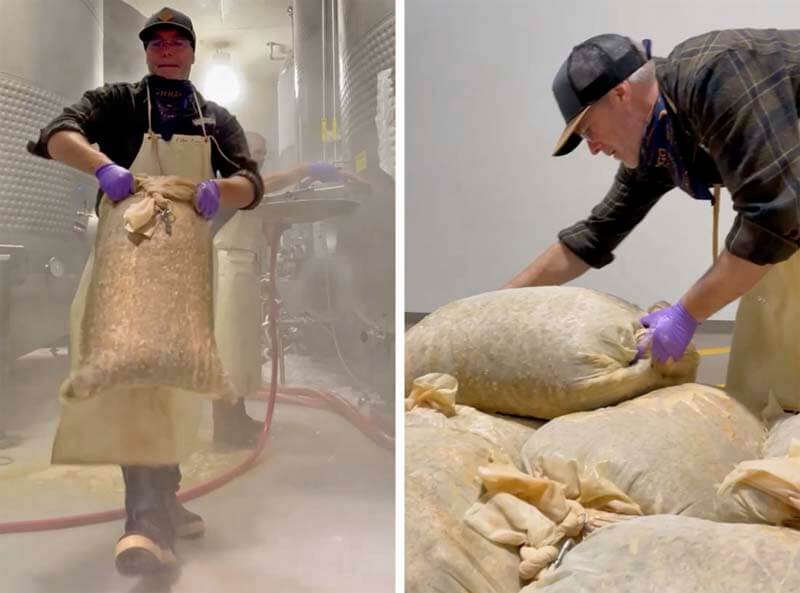
Craft beer consumers love to drink IPAs. That is a fact. And it has been fact for the last two to three decades.
Last year, the style “IPA – American” ranked first on the Untappd app with over 7.2 million check-ins, followed closely by “IPA – New England” with over 6.1 million and “IPA – Imperial/Double” with 4.1 million check-ins.
According to recent NielsenIQ data analyzed by Bump Williams Consulting (BWC), hazy imperial/double/triple IPA dollar sales increased +128.7% to $33.3 million, more than doubling. And overall, IPAs still account for forty-six percent of craft dollar share.
Across the world, breweries have raced to stay up to date with up-and-coming hop varieties and new products and technologies.
Dry hopping is one of those techniques. Although commonplace at this point, dry hopping became so incredibly popular because it enhances hop flavor and aroma, impacts mouthfeel, and even augments perceived bitterness. That added layer of depth and complexity has made dry hopping an incredibly effective technique for giving beers a unique character.
At this point, anything on the shelf with the words “dry hopped” or “double dry hopped” (DDH) seems to immediately catch a consumer’s eye, signaling a more bitter, bolder IPA. In essence, dry hopping has certainly become an invaluable tool in a brewer’s belt, but also in a brewery’s marketing strategy as well.
But just as our most recent Essential Guide to Brewing Coffee Beers proved that there are a myriad of permutations when it comes to brewing coffee beers, when it comes to dry hopping there are so many different variables to consider.
With that in mind, we’ve done our best to break down those crucial questions, speaking with Sapwood Cellars Co-Founder and Author of The New IPA: A Scientific Guide to Hop Aroma and Flavor Scott Janish along with Bell’s Brewery Brewmaster Andy Farrell on all things dry hopping. Everything from the cost of dry hopping to the ideal amount of hops to use in a dry hop to the best temperature to use, and as much as we could cover in between.
Above Photography courtesy of Sierra Nevada
What We’ll Cover in This Piece:
Affordable, Industry-Leading Brewery Software
What Are the Benefits of Dry Hopping?

Photography courtesy of Bell’s Brewery
First, to make sure we’re all on the same page: When we say dry hopping, we mean “anything introducing beer to hops post kettle,” says Janish. “Anything that’s going into the fermenter I would consider dry hopping, even if that’s the first day of fermentation or post-fermentation.”
Janish has literally written the book on everything to do with hops and dry hopping. Through his own experiments and lab tests, discussions with researchers, and interviews with renowned and award-winning commercial breweries, Janish has become an expert on dry hopping.
For Janish, the value of a dry hop is how it enhances a beer’s aroma and flavor.
“People like those explosive flavors,” he says. “Hops, especially modern-day hops, can bring that to a beer, make it jump out of the glass, and give you that ‘wow’ factor when smelling a beer. There is a reason hoppy beers have been so popular for so long… Dry hopping creates an approachable ‘wow’ beer.”
And Bell’s Brewery Brewmaster Andy Farrell, whose twenty-two years with the iconic brewery have included brewing the revolutionary dry-hopped beer Two Hearted, agrees. “At that highest level, you’re trying to extract amazing flavor, aromas, and compounds out of hops,” he says. “But going a level down as a brewer, a successful dry hop extracts specific characteristics you’re looking for in a good beer… Am I trying to go for floral, piney, and grassy, or am I trying to go for tropical, pineapple, guava, and mango?”
Ultimately, there are a lot of factors you need to acknowledge before that flavor-packed ‘wow’ beer makes it onto the shelf.
The Two Temperature Ranges to Consider for a Dry Hop
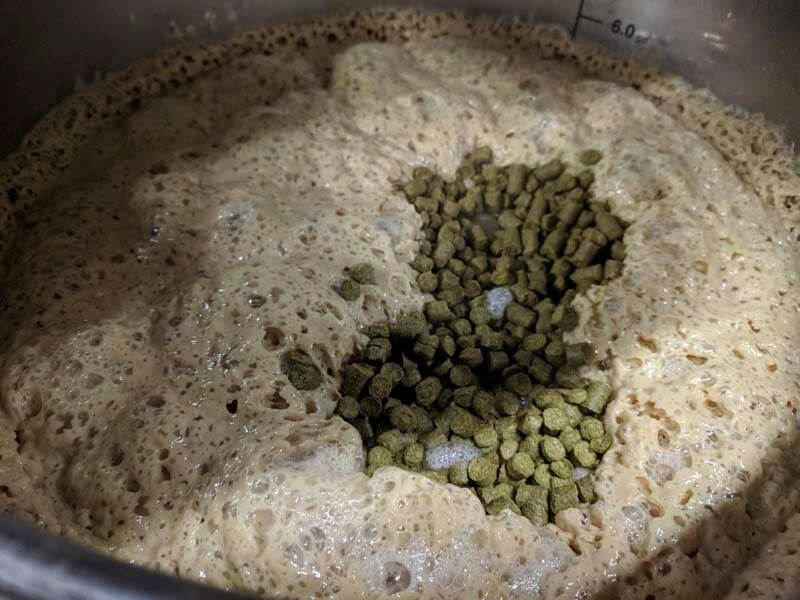
Photography courtesy of Scott Janish
One of the most important considerations when it comes to a successful dry hop is temperature.
And you can either go warm/ambient or cold.
Warm/Ambient Dry Hop
More of the standard old-school practice, warm/ambient dry hopping occurs at 70+F, according to Janish. Basically, the temperature of your beer post-fermentation.
While Farrell says Bell’s doesn’t share the exact temperature for their dry hop, he emphasizes that dry hopping works best for them during primary fermentation. “We tend to get better characteristics and the ones we’re targeting out of the hops at warmer temperatures,” he says.
A warmer dry hop also has one big benefit: fighting off hop creep. “Warm temperatures means yeast is in suspension,” says Janish. “If hop creep happens at that warmer temperature, you still have a lot of yeast in the beer… It will be active and clear itself up, so you don’t have to worry about hop creep anymore.”
Additionally, with a warm dry hop you get a better extraction rate from the hops, according to Janish, who says that the hops are less likely to fall out of suspension, but rather stay active inside the tank. “I suspect with warmer dry hop temperatures, hops naturally stay in solution a little longer and are extracting slightly better or without having to do process maneuvers to keep them in suspension.”
Warmer dry hops may be a little easier, but nowadays a lot of brewers are starting to cold dry hop for one big benefit: flavor impact.
Cold Dry Hop
Dry hopping at colder temperatures starts around 58F or the temperature of your soft crash, according to Janish. “This is enough to get the yeast to drop out so you can harvest and get the rest out of the cone and dry hop at the same time,” he says.
A proponent of cold dry hopping, Janish says that he kept coming across this technique in a lot of the papers and research he unearthed. “That’s a good telltale sign to start experimenting with it at the brewery,” he says.
Which he did, of course. In his own cold dry hop trials, flavor seems to be the main benefit.
Janish found that with cold dry hopping, “a lot of the greener, more astringent, spicier, woodier compounds in hops extracted less efficiently at colder temperatures, but the more soluble and fruity compounds were not impacted as much.”
He continues, “Getting more of the fruit-flavored citrus flavors that are oxygen-sustaining compounds in the beer at pretty much the same levels, but keeping down more astringent greener compounds, to me that makes a more drinkable beer.”
And while cold dry hopping may start around 58F, Janish says that breweries have gone even colder, moving towards 40F and even a little lower. “That’s especially true in some lower alcohol beers where a heavy dry hop load on a lower ABV beer can come across pretty astringent and rough,” he says. “So for us, going cold on those lower ABV beers helps create a more drinkable beer sooner.”
Cold dry hopping also reduces the contact time needed for a dry hop.
According to an article from BSG called Reevaluating Dry Hop Techniques, “In fact, linalool extraction time was reduced when dry hopping occurred at cooler temperatures (34-39°F, or 1-4°C), finding maximum extraction after two days. Linalool levels were the same in warmer dry hopped beers after two weeks.” (Dry Hopping – A Study of Various Parameters).
Although, one thing to note with cold dry hopping: You’ll most likely need to figure out a way to rouse or agitate the hops. “I found the colder the beer is, the quicker the hops want to drop to the bottom of the tank,” says Janish. “When they’re sitting at the bottom, they’re not doing a whole lot for you at that point.”
A Note on Rousing/Burping
At Sapwood Cellars, Janish blasts CO2 through the bottom of their tanks with a high-flow regulator to push the hops back into more suspension, ensuring they extract efficiently.
Another technique to rouse or “burp” the hops is recirculation. Essentially, going in and out of the tank with a pump to encourage the hops to be in suspension.
For burping, Janish says they typically do one burp a day for two days (this is for each dry hop dose, usually two doses).
“If you’re more efficiently extracting the hops, you could back down the amount as well,” he says.
Farrell notes that whatever method you choose, you should “approach these beers more like a chef than a chemical engineer,” emphasizing that you just need to pull these different levers and experiment with the results until you dial in on one you like.
For example, even the amount of time that you’re dry hopping varies brewery to brewery.
The Ideal Contact Time for a Dry Hop
Ask ten different brewers this question (and in fact every other one in this guide) and you might get ten different answers.
“The timing of a dry hop addition is important in part because of the outcome, the actual flavor you’ll get from the hop,” says Janish. “Timing overall can impact how the hop actually shows itself.”
Traditionally, about a week at room temperature was considered the ideal contact time for a dry hop. Perhaps some might call that “old-school.”

Photography courtesy of Sierra Nevada
At Bell’s, Farrell says they’ve really dialed in their dry hopping process over the years, landing on the three- to five-day range as the middle ground. Of course, Farrell says it really all depends on a bunch of other huge factors, “like whether we’re agitating, [the] temperature of the beer when dry hopping, and what you’re trying to get out of the hops.”
Because, if you leave the hops in for too long, you will risk reaching a saturation point, where you’re no longer extracting the flavor you want. In fact, you could get detrimental flavors. Farrell likens it to “over extracting your morning coffee,” pulling out harsher tones you might not want.
“The thought was if you dry hop for too long, you would get really green flavors,” says Janish. “The longer you dry hop, the more you’re getting those harsher compounds…[that] in too high amounts can have a negative impact on the beer.”
Janish says about four days at higher temperatures is when you risk seeing that turn.
Recently, studies have shown that a twenty-four-hour dry hop might be all you need. According to an article from BSG, “Several studies have shown that concentrations of monoterpene alcohols and hydrocarbon hop fractions reach near-full extraction in beer after being on dry hops for just twenty-four hours. Further, some of these constituents can come out of the beer solution and back into hops due to those aroma compounds’ hydrophobic nature. Additionally, hop thiols such as 4MMP, known for their fruity, tropical aroma, are also extracted rather quickly, with most being found in beer within two days of dry hopping.” (A Study of Factors Affecting the Extraction of Flavor When Dry Hopping Beer, Peter Wolfe).
Janish has found the same, especially if you’re cold dry hopping and you’re rousing well. At Sapwood Cellars, each dry hop charge gets two days of contact time at a cold temperature.
He gives this example:
“Basically, if we just dry hopped yesterday for a pale ale with a single dry hop addition, at 34 degrees, that we burped at night (which means we blew CO2 through the tank to get the hops in suspension) and we burped it again in the morning, tonight we’re already dropping those hops out of the tank,” he says. “We are trying to get rid of them already on that second day.”
Janish says the shorter contact time has multiple benefits.
“It speeds things along, it gives us more of what we’re after from the hops, and if you’re already going to take your beer down to 34F degrees anyways to carb it, you’re already ahead of the game a little too,” he says.
Because when it comes to dry hopping, working smarter, not harder, is definitely the name of the game.
What Types of Vessels Are Used for Dry Hopping?
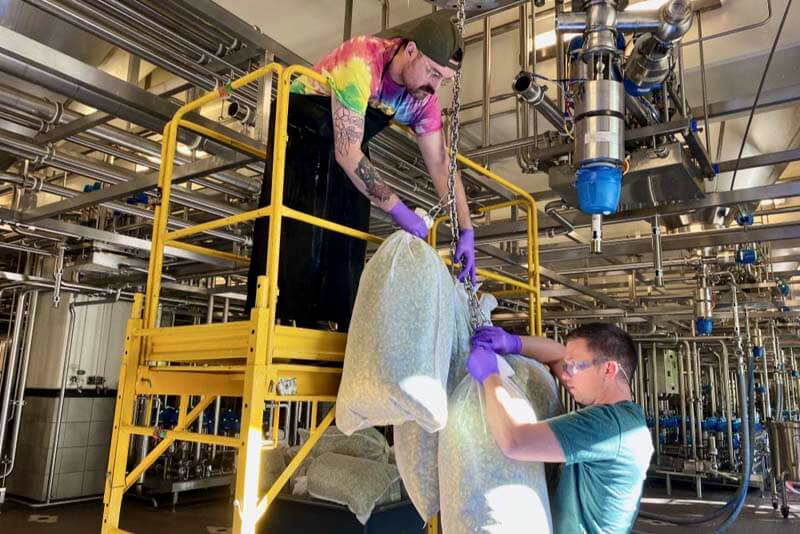
Photography courtesy of Sierra Nevada
There are numerous different vessels used in dry hopping or introducing hops into a fermenter. And again, talking to different brewers produces different answers, so while we won’t cover them all, here are a few typical practices.
In the past, a common method for dry hopping has been filling nylon bags with hops and dropping them into the fermentation tank. Just like putting a tea bag into a hot cup of water.
Or to simply dump in hops from the top of the tank. “We love adding hops through the top,” says Farrell. But for those tanks that don’t have hatches at the top, he says Bell’s adopted a system “where we…can load a hopper that’s attached to centrifugal pump with a pre-laid hop charge; we like to do a CO2 purge and then as we circulate the beer there is a valve that slowly opens and introduces the hops into process.”
Those two methods have worked for the larger Bell’s over the years, but smaller breweries might have their own designs.
For the most part, especially at smaller breweries, tank space (and just space in general) can be very tight. “We don’t have a lot of fancy equipment when it comes to dry hopping,” says Janish. “We do every one of our hoppy beers in the same tank it’s fermented in.”
Janish follows what’s called “unit tanking.”
Unit Tanking
“You ferment in one tank, drop out the yeast in that same tank, dry hop in that tank, drop the hops out of that tank, carb in that tank, and package from that tank,” he says. “It’s actually a good thing because you’re not allowing a chance for oxygen to get in if you were to transfer to another tank.”
Each brewery has its own method that will differ whether they’re a small or large brewery. Obviously, a larger brewery may have fancier equipment, especially to introduce the hops into the fermenter.
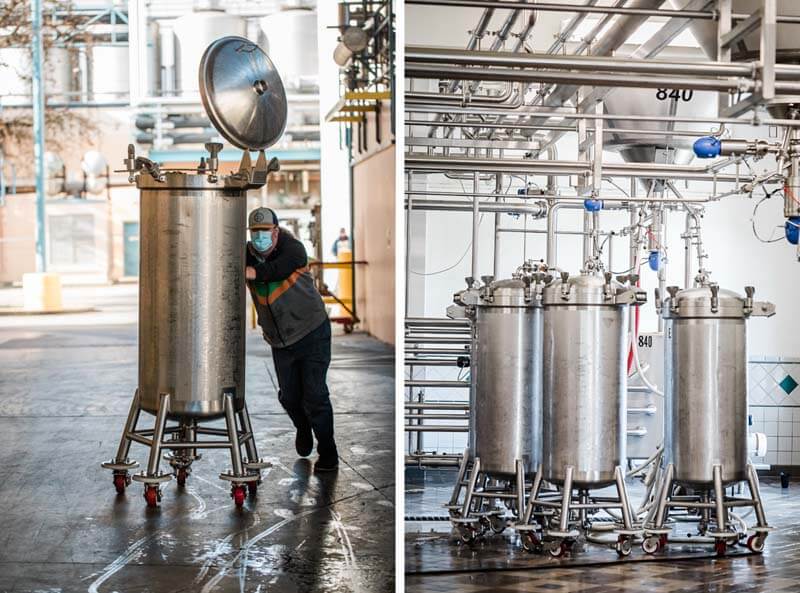
The Hop Torpedo at Sierra Nevada | Photography courtesy of Sierra Nevada
And some have even invented their own methods. For instance, the Hop Torpedo at Sierra Nevada, which holds seventy-five pounds of whole-cone hops that beer circulates through from the fermentation tank and back in again.
Not everyone has the opportunity to build custom devices, though, so there are some pretty standard options out there.
Dry Hop Doser / Hop Gun
At Sapwood Cellars, Janish found that a dry hop doser works really well. Essentially just another little vessel that sits on top of the tank and can hold 22 lbs of hops, a dry hop doser “is a beneficial way to add hops to our beer without oxygen pickup,” says Janish. “You add hops to that vessel, close it up, and purge it with CO2, and then you can have that container under pressure, open up the valve to the tank and have the hops drop in and they’re never exposed to outside air, so oxygen shouldn’t be getting in.”
There are many different products out there to introduce hops into your dry hops. Janish suggested two others:
Iso-Mix External Drive
Developed in 2017, this machinery includes a rotary jet mixer that is placed under the tank, allowing the hops to be pushed into the tank and stay in suspension. Benefits include reducing doses by twenty percent and hopping time by fifteen percent. The Iso-Mix External Drive could be a good piece of equipment for larger breweries with larger tanks.
Explore your options, find what works best for your brewery.
What Is the Ideal Quantity of Hops to Use in a Dry Hop?
There isn’t necessarily a one-size-fits-all answer here. Much of the amount of hops you want to use depends on the type of beer you’re trying to make and the set-up in your brewery.
For instance, when Bell’s first formulated the recipe for Two Hearted, that dry hop was one pound per barrel. “When that [beer] was developed, that was a lot of hops for a dry hop,” laughs Farrell. “Everyone knows now the amount that goes into a lot of beers is quadruple, five, or six times that amount.”
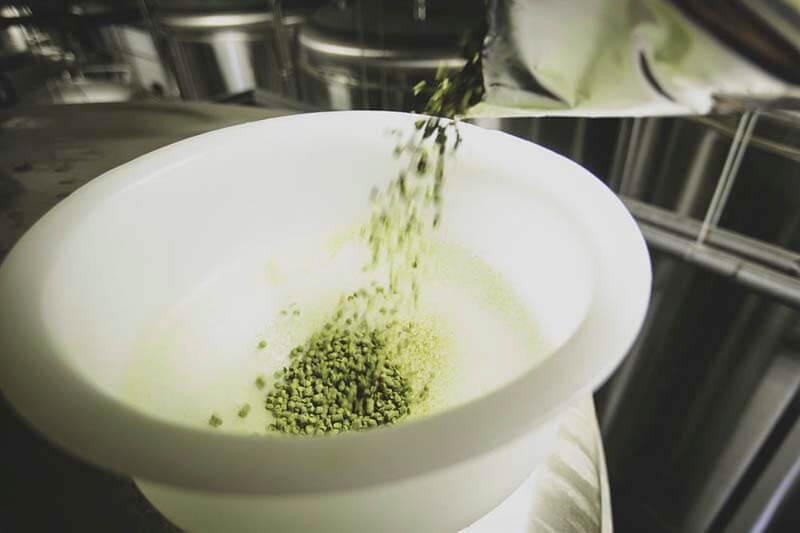
Photography courtesy of BSG
Typically today, Farrell says that for a modern, normal-strength IPA, Bell’s will start off with at least 1.5-2 lbs/bbl and then, depending on the goal of the final beer, hone in on their ultimate usage rates. “I would say for a modern beer, 2 lbs/bbl is a good place to start and you can take it up or down from there based on the results as you trial your recipes.”
At Bell’s, they have limited pub-only releases that use 3 lbs/bbl or even a recent speciality release only available in their Kalamazoo taproom called Side Yard that include five hop additions and a dry hop north of 5 lbs/bbl. “That [beer] has a really amazing aroma, but the complexity of the process doesn’t make it good for scaling,” says Farrell. Again, it all just comes down to your goal and the equipment you have available to you.
“You can get really heavy handed on the hops if you have a centrifuge and you’re whipping beer though it after dry hopping and pulling out a lot of the harsher greener hop compounds,” says Janish.
But if you don’t have that piece of equipment in the brewhouse, you probably need to be more conservative.
Janish says at Sapwood Cellars, which puts out about 1,000 bbls a year, generally 4 lbs/bbl for an IPA is standard. While a pale ale drops down to anywhere from 2-3 lbs/bbl. And a triple IPA will go higher at 5 lbs/bbl.
But again, it all depends on your end goal with the beer. “Sometimes we want to push the resinous edge to beers and we’ll do a triple dry-hopped double IPA which will be closer to 5 or 6 lbs/bbl in that dry hop,” says Janish. “And that will be a hit!”
The best advice Janish can give here is to do your research. He says starting as a homebrewer and testing hundreds of batches helped build up his dry hopping confidence. Along with interviewing other respected breweries for his book. “I don’t have a perfect answer for you,” he says. “It was a little bit of convenience, a little bit of what others do, and a little bit of what my experience has been.”
The amount of hops you use will all just depend on your goals, the equipment you have in place, and the price you’re willing to pay.
What Is the Cost of Dry Hopping?
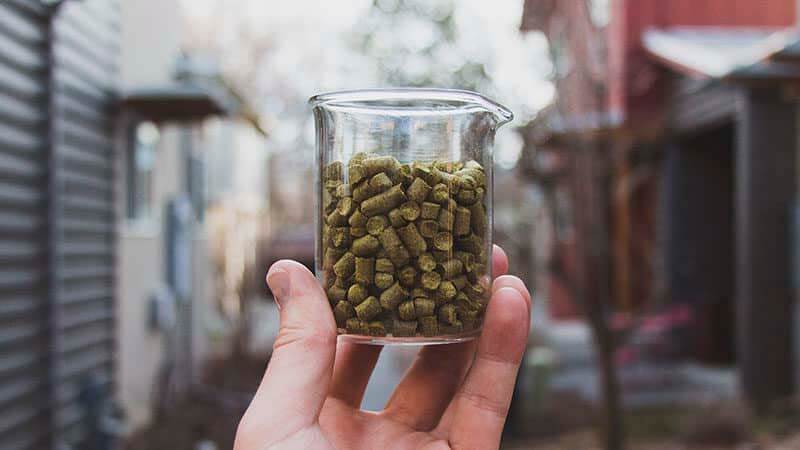
Photography courtesy of Brew Cabin
We’re going to lay it out here plain and simple: Dry hopping will cost you money in the short term.
And for two reasons.
One being that you’re using extra hops which come with an added expense. That reason is pretty easy to see and explain.
“If you look at a typical dry-hop beer, it’s not out of line to say that as much as probably eighty percent of your total hops are coming through a dry hop,” says Farrell. “So it increases the amount of hops exponentially in your beers, which increases the cost.”
In a word: Dry hopping can be costly.
“Dry hopping certainly increases the cost of the beer to produce,” says Janish. He gives an example of Sapwood Cellars’ most-popular dry-hopped beer Snip Snap with Galaxy, Citra, and Citra Cryo hops:
“We’re drying hopping Snip Snap at 4.4 lbs/bbl and Galaxy typically costs us ~$16/pound, Citra (~$16/pound) and Citra Cryo ($33/pound), so dry hopping alone would cost us something like ~$2,000 for a 20-bbl batch.”
The second reason is a bit harder to see. Dry hopping a beer means that your final yield will be lower.
Farrell says some extremely high hopping rates, depending on the equipment and technology used in the brewery, “could absorb thirty to forty percent of the beer you’ve made, and that’s obvious cost.”
Plus, there are costs, labor, and time associated with everything in a dry hop, including removing the leftover hops from the beer, getting rid of the material, and even cleaning.
You’ll need to decide whether the juice is worth the squeeze, obviously.
And it’s why new products like SPECTRUM are worth investigating too. A groundbreaking new product from the venerable hop supplier BarthHaas, SPECTRUM is a liquid dry-hop replacement that purportedly saves you time, money, and physical beer.
Janish does note that while he doesn’t have any analytical data, he says anecdotally beers that he markets as DDH tend to sell well. “If we’re dry hopping a beer, we’re definitely putting DDH on the can,” says Janish.
So while dry hopping costs more, there is more opportunity to price your products higher, add words like “DDH” or “double dry hopped” to the can, and sell those beers quicker.
The Best Hops for Dry Hopping

Photography courtesy of Yakima Valley Hops
For the most part, Janish says for dry hopping he likes to stick to the following hops: Mosaic, Galaxy, Citra, Nelson, Riwaka, and Simcoe.
“Those are all hops that, whether on their own or in combination, can really produce some amazing beers,” he says. “Those are heavy hitters.”
In fact, he has a whole series of IPAs that he just calls “Cheater Hops” that feature some combination of the above.
And if he had to pick just one hop to use in a dry hop?
“I love using Nelson,” says Janish. “It is one of my favorite hops. Anything we dry hop with Nelson tends to be pretty good.”
For his favorite hops to use during a dry hop, Farrell picked Centennial and Strata.
Why the slightly older-school Centennial?
Well, probably because Bell’s is the single largest user of Centennial hops in the world. Annually, Bell’s buys north of half a million pounds. And Paul Bashaw, who is in charge of hop procurement and raw materials inventory control at Bell’s Brewery, says that last year Bell’s purchase of Centennial hops accounted for just a shade over an eighth of the entire crop.
“As much as I have used historically, it’s such a complex, awesome hop,” says Farrell.
More recently, Strata has wowed Farrell. “Strata is consistently such a high-intensity hop,” says Farrell. “For us, we get a ton of pineapple, guava, almost melon character in the background… Its a big citrus bomb with complexity and intensity. It’s a f***ing awesome hop.”
The Three Best Tips on Dry Hopping

Photography courtesy of Bell’s Brewery
These are the essential tips and tricks you can only know if you’ve dry hopped hundreds of times.
1. Source Great Hops / Smell the Hops Before Using Them
Farrell says he can’t stress enough how important it is to form great relationships with your hops suppliers, “finding the best hops you can.” He cites those friendships with hops growers as one of the key successes to Two Hearted. “It matters when you throw your hops in and pay attention to your process, but try to ensure you’re getting the best hops you can [too].”
Even after you’ve sourced great hops, one of the best pieces of advice Janish can give is to listen to your senses. “I think some brewers likely don’t trust their nose enough when dry hopping,” he says. “If the plan is to dry hop with Citra for example, but the bag smells like onions, it’s going to smell like onions going into the beer. Smelling the hops before using them and pivoting if you have to to another source of a different hop variety that smells better are good practices if it’s feasible. The quality of the pellets matters a lot!”
2. Balance With Residual Sweetness
If you’re dry hopping at a higher rate—around 4-5 lbs/bbl—Janish recommends building a recipe that increases the residual sugars. “Mash warmer to leave more dextrins (unfermentable sugars) or add something like maltodextrin to build that sweetness into a recipe,” he says. “If you’re doing a heavy dry hop…you need a little bit of residual sweetness in those beers to balance that heavier dry hop.”
3. Consider Additional Hop Products
Especially if you’re a smaller brewery, both Farrell and Janish recommend exploring the benefits of new hop products in the market.
Pretty much every big hop supplier has a version of a lupulin-enriched hop product, whether that’s Cryo Hops from Yakima Chief Hops or LUPOMAX from John I. Haas. Even if you just mix in your traditional T-90 pellets with some lupulin-enriched ones, you could see yield and cost advantages.
“If you can, utilize those in a way especially as a smaller brewer that takes down your overall input and you do absorb less beer in the tank,” says Farrell. “That can be a way to approach a challenge for a small brewer.”
Just Experiment, Experiment, and Experiment Some More
If you take one tip away from this entire guide, it’s that when you’re discussing dry hopping, “If you talked to ten different people, you’ll get ten different answers,” says Farrell.
His best piece of advice is to experiment and find what works best for you.
“The way you do things matters a lot and you’re going to find the best results through experimenting yourself and figuring out how to attain your goals from a given recipe,” says Farrell. “Knocking it out the first time happens occasionally as a brewer, but most of the time you have to [constantly] work to get [the beer] where you need.”
For More Information
We highly recommend using these resources for more detailed, technical information:
- BSG’s Reevaluating Dry Hop Techniques
- The New IPA: Scientific Guide to Hop Aroma and Flavor – Scott Janish
- For the Love of Hops, The Practical Guide to Aroma, Bitterness and the Culture of Hops – Stan Hieronymus
- A Study of Factors Affecting the Extraction of Flavor When Dry Hopping Beer – Peter Harold Wolfe
- Dry Hopping – A Study of Various Parameters – Hopsteiner
- Dry Hopping Potential of Eureka! A New Hop Variety – Hopsteiner
- The Effect of Pellet Processing and Exposure Time on Dry Hop Aroma Extraction – Peter Harold Wolfe
- A Comparison of Single-Stage and Two-Stage Dry-Hopping Regime – Dean G. Hauser, et al
- Influence of Hop Oil Content and Composition on Hop Aroma Intensity in Dry-Hopped Beer – Daniel Vollmer and Thomas Shellhammer
- Investigating the Factors Impacting Aroma, Flavor, and Stability in Dry-Hopped Beers – Scott Lafontaine and Thomas Shellhammer
Brew Your Best Dry-Hopped Beer With Ollie
Ollie is brewery management software built by brewers, for brewers. From robust inventory management to automated reporting, Ollie is the ultimate tool to ensure your brewery business never misses a beat. Check out a free demo today and learn why breweries all over are making the hop to Ollie.



